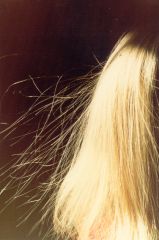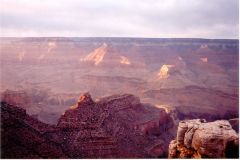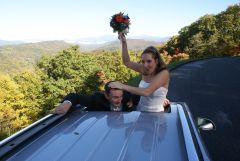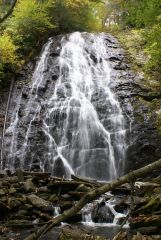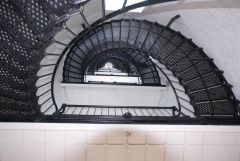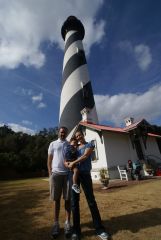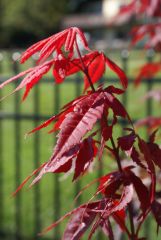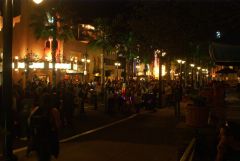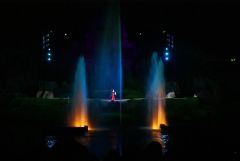-
Content Count
591 -
Joined
-
Last visited
-
Days Won
8
Content Type
Profiles
Forums
Blogs
Gallery
Everything posted by -Gramps-
-
Lenses: To quote Sony.com “Every Lens tells a story!” That is not true. Not completely anyway. A lens does no good unless it is attached to a camera, and the camera is only as good as the eye looking through it. Then again it is true if you remember that an eye is also a lens; a lens attached to a photographer. It is up to the photographer to tell the story. It can be a story about love, or friendship, history, the beauty of nature. It can be sensual. A lens is a tool to make that story visible. I want to remind you that if you are using an APS-C sensor camera the focal length of any compatible lens is based on the 35mm film and APS full frame equivalent times the crop factor of 1.6. http://community.fmca.com/blog/62/entry-1382-depth-of-field/ Lesson two. There are three basic types of lenses: Fixed focal length; which includes wide, fisheye, normal or prime, and telephoto lenses. Zooms, which can also be wide or telephoto or a combination of both. Macros, which are also known as, close up lenses. These are also fixed focal length lenses. Any zoom that claims to be a macro lens, well it isn’t. Fixed focal lengths come in various lengths and f-stop configurations. First is the normal lens. The term “normal” refers to the angle of view that the human eye sees when looking straight ahead. This normal angle of view is pretty close to a full frame 50mm lens. When using an APC-C camera normal would be approximately 35mm. (35 times 1.6 equals 56). I mentioned 35mm because that is a very popular focal length. A 30mm lens is also available from some manufacturers. If the normal angle of view of the human eye (which is a lens) is equivalent to a full frame 50mm lens, than any lens with a greater angle of view is a wide lens and any lens with less is a long lens. Once again depending on the sensor, a normal or prime lens, as some call it, can be 28 to 50mm in length. A fast normal lens with a large aperture of f-2.8 or more makes a great lens for shooting pictures in low light. I own a 35mm f-1.8 lens. A 50mm lens when used with an APS-C camera makes a really good portrait lens. A 50mm prime lens can bring a person close enough for a head and shoulders shot without standing on top of them. If you set the f-stop at 3.5 or lower you will create a nice bokeh effect. Bokeh is the blurred image behind your subject. My 50mm f-2.8 Macro prime lens creates a very pleasant bokeh which I take advantage of for both portrait and close up nature shots. A wide angle lens pulls into the frame and focuses what a human sees with their peripheral vision. Wide angle lenses have a very wide depth of field, meaning that the foreground and the background will be in focus at just about any f-stop setting of the lens. Wide angle lenses have the ability to make an object or person that is close to you look farther away than it really is. Ultra wide angles, such as a 12mm fish eye lens, which can have a 180 degree angle of view, will also distort what you are looking at. This is the peep-hole effect and depending on the lens and sensor size, it can be very pronounced. I enjoy using a wide angle lens for landscape and scenic photography. I can capture all of a waterfall or a stream, a big wide sunset over the Grand Canyon. I am not a fan of fish eye lenses for a couple of reasons, one; I don’t like the extreme distortion, and two; a good fisheye lens cost as much as two good prime lenses. I also use my wide angle lens for taking group, architecture and interior shots. I happen to own a Sony 11-16mm wide angle zoom. It was expensive but well worth it. The primary function of a telephoto lens is the same as a telescope, to bring distant objects into closer view. The too technical definition of a telephoto lens is that the physical lens is shorter than the focal length and that the lens is constructed of groups of lenses called elements to bend light in certain ways to prevent fringing and distortion and make the image as sharp as possible. I don’t own a telephoto lens. I used to. A medium telephoto is between 85mm to 135mm in 35mm format (film again?). A super telephoto is over 300mm in 35mm format. The most common telephoto lenses manufactured by camera makers or lens makers are 85mm, 100mm, 135mm and 500mm lenses. Along with being fixed focal length, these lenses have something else in common, they are very expensive. Telephoto lenses are usually fast, they have a maximum aperture of 2.8. This gives them a physically large size and price tag to go along with it. The longer the lens is, literally, the bigger the price. It is my opinion that unless you need one for a very specific application, like shooting sports at night for example, your money is better spent for a good telephoto zoom lens. I mentioned that I used to own a telephoto lens. It was a really nice Minolta MD 135mm f-2.8 that I traded a zoom lens for. This was over twenty years ago when I had my own darkroom. At that time, I didn’t care for the quality of the shot from, or the physical size of, a zoom lens. I found that fixed focal length lenses produced a sharper image that was much better than a zoom set at the same focal length. Fixed focal length lenses were lighter, and faster. That is somewhat true today, but zoom lenses are much better constructed than they used to be, and they are more versatile than a fixed focal length lens. That is why I own four of them. In my bag is an 11-16mm wide angle zoom, a 55-200mm zoom, a 70-300mm zoom. Normally attached to my camera is the kit lens that came with it: an 18-55mm zoom lens. The last lens has an aperture of 3.5-5.6. Why two f-stops? That is because it is different at the minimum and maximum zoom setting. At 18mm the maximum aperture opening is 4.5 and at 55mm it is 5.6. All my other zooms have a maximum f-stop range of 4.5-5.6. This is rather typical of any manufacturer’s zoom with the same focal length. So far we have learned that fixed focal length lenses tend to be faster than a zoom so they are better for low light shooting, especially so if you want to hand hold the camera. That is why I own a 35mm f-1.8 “normal” lens. A 35mm APS-C lens is equivalent to a 50mm full frame lens. I also own a 50mm full frame f-2.8 lens which I use for portrait shots. My fixed focal length lenses are not as versatile as my zooms when composing because if I want a tighter shot, I have to move closer to the subject, and if I want a wider shot, I have to move back. Zoom lenses allow me to change my angle of view without moving as much. However, zoom lenses do not usually have as large an aperture as a fixed focal length lens, not without paying a huge amount of money. They are bigger in size so not easy to hold steady when shooting in low light. Using a tripod when shooting in low light with a zoom is a good idea. Last but not least is the macro lens. As I stated earlier, a zoom lens is not a photomacrography lens, even if the manufacture says it is. It simply does not have the 1:1 reproduction/magnification capability of a true macro lens. A zoom lens cannot produce an extreme close up shot resulting in a greater than life size image on the sensor. Of course, it is possible to produce a greater than life size image when viewing or printing an image. Sony has three macro lenses, a 30mm f-2.8, a full frame 50mm f-2.8 and a full frame 100mm f-2.8. The 50mm and 100mm lenses both have the advantage of allowing you to be farther away from your subject (we are talking inches) than the 30mm and still capture a 1:1 image. When shooting live subjects from farther away, even if it is only half a foot, is not a bad thing.... it keeps the butterfly from well, flying away. Both the 50mm and 100 mm lenses cost quite a bit more than a 30mm lens. I choose to purchase the 50mm lens (used) because I also wanted to use it as a medium telephoto lens. The 100mm, when the crop factor is applied, made it a 160mm lens which was a bit longer than I wanted. Remember that a Macro lens needs quite a bit of light to take an extreme close up picture. The depth of field will be very narrow and moving the camera a very small amount either closer to, or away from, the subject can dramatically change the DOF. A larger number f-stop setting helps to increase the DOF, but the shutter speed is going to be longer (slower) so mounting the camera on a good tripod is highly recommended. This was a very basic lesson about lenses, but my hope is I supplied enough information for you to make a wise decision about which lenses you want in your bag. Next lesson: Using the most important lenses you have: Your eyes! http://community.fmca.com/blog/62/entry-1392-the-rule-of-thirds-using-your-eyes/ Gramps
-

Christchurch – Gateway to Antarctica
-Gramps- commented on tbutler's blog entry in Tom and Louise on Tour in North America
Nice entry Tom, I suspect you will resize the last line (you are online right now!) What is the time difference? Thirteen hours or so? That is what is was when I was in Diego Garcia a few years ago.- 2 comments
-
- Campervan
- Antarctica
-
(and 5 more)
Tagged with:
-
I really enjoy photography. It is the art of capturing a moment in time. Like any art form it is subjective and therefore what constitutes a good picture is really a matter of opinion. I learned that really fast from the people judging the very first contest I entered. What I thought were my best pictures received no mention and one that I entered as a lark in the still life category, almost took best in show. The most important thing is to know how to use your camera in order to take the picture you want at the time you want it. http://community.fmca.com/blog/62/entry-1378-a-bit-about-digital-photography/ Lesson one. So let’s continue. What is Depth of Field or DOF? Manipulating the DOF can change a picture dramatically and turn a simple shot into a really good one. DOF determines how much of the subject or scene you are looking at through your camera’s viewfinder is in sharp focus. Let’s change that to say acceptable focus. The area outside the part of the picture that is acceptably focused is known as the “Area of Confusion." The DOF focus range depending on the lens, can be from a couple of inches in front of the lens to infinity. Depth of field is determined by how far the lens aperture is open at the time of exposure. The smaller the aperture opening the greater the area that is in acceptable focus. The larger the opening the smaller the area in focus. f-22 provides a much greater DOF than say f-2.8. That is why shooting in low light makes shallow DOF easier to obtain or harder to avoid. When you look through the viewfinder the aperture is always wide open. If the f-stop, which controls that opening, changes automatically or by you because the amount of light reflecting off the subject increases or decreases, that f-stop change does not physically happen until the shot is taken. The reason for this is so while you are composing your shot, the image on the focusing screen will be as bright as possible so that you can focus. If the camera were to stop the lens down say to f16 while you are looking at the subject, the screen would go very dark. However, you may want to see the effect of the depth of field before you take the shot so many DSLR cameras have a DOF preview button. My camera has one. I focus on my subject, depress the button which allows me to see just how much of the picture is in focus, and if I like what I see I release the DOF button and press the shutter release. When taking a picture you really only focus the lens on one point, perhaps a person’s eyes, the center of a flower, a snowy peak in the middle of a mountain range, a rock formation in the Grand Canyon. Depending on the lens, and the aperture setting, the person’s face will also be in focus, but the background or the foreground, or in some cases, both will not. At the same f-stop a wide angle lens will have a greater depth of field than a longer lens. When shooting very close up shots with a high magnification lens, also known as a Macro lens, the depth of field will be very small. I now need to give you a small review. I told you in our first lesson that digital photography is based on film photography standards. It is important to remember that. Film cameras were and still are available in different sized formats. As I stated most DSLRs are built along the same design as a 35mm SLR. I didn’t tell you that also like film cameras, a DSLR is available in different formats. They are based on two different sized digital sensors: The full frame APS and the smaller APS-C APS stands for Advanced Photo System, An APS-C or compact sensor is smaller than a 35mm frame by quite a bit. This difference in size is called the crop factor. The 35mm format makes the angle of view larger (wider) by a factor of 1.6 as apposed to an APS-C camera. The crop factor leads to quite a bit of confusion when understanding lens focal lengths, which leads to confusion about the depth of field range of that lens. It gets even more confusing when you learn that APS-C cameras can use lenses designed for 35 mm cameras as long as they have the same lens mount. Lenses made specifically for APS-C cameras still use the same angle of view scale as they would if they could be used on a 35mm camera body, which they cannot. Well, they will mount, but if you did use one on a film camera it would cause vignetting, a darkening around the edges of the picture. Here is the really interesting part of all this. If you want to spend some big bucks you can purchase a full frame APS camera. The sensor will be the same size as a frame of 35mm film.. If you did that then you would need to also purchase lenses designed for use on that full frame camera. Those lenses will usually work with the same manufacturers APS-C camera, but remember, not the other way around. Confusing ain’t it? Here is a quick summary of the above. My Minolta 35mm auto focus lenses will mount and work on both my Sony Alpha DSLR cameras because Sony purchased Minolta in 2005 and kept the same lens mount. The auto focus lenses that came with my Alpha DSLR cameras will mount on my 550si 35mm camera but they cause the vignetting effect. There are other auto exposure limitations as well; in other words they are not a good fit. I own two full frame APS lenses that will fit and work on all my SLR cameras. If I were to purchase a professional APS full frame DSLR from Sony (I would love an A99!), those two lenses would work just fine with that camera. I can only hope to find out just how good one day. I leave you with this last bit of info. There is a scale etched on any DSLR lens I have ever seen. The scale is exactly the same for full frame lenses or APS-C only lenses. The scale is equal to the scale etched on a 35mm camera lens. The lens could have a depth of field scale that also matches a 35 mm camera lens of the same focal or zoom length. A 24mm wide angle full frame or a 24 mm APS-C lens mounted on an APS-c digital camera is no longer a 24 mm wide angle lens. The crop factor of 1.6 converts that lens to a 38.4 mm lens that has a slightly narrower depth of field. A 100mm portrait lens mounted on an APS-C camera becomes in effect a 160mm telephoto lens with an extremely narrow depth of field at just about any f-stop you use. Like you I don’t know why lens manufactures don’t have a lens scale specifically for APS-C cameras. They have chosen to leave 35mm numbers as the standard and we must learn to deal with it. That is the purpose of this posted lesson, to help you deal with it. If you reply with a question I will be more than happy to answer it. My next entry will deal with the various types of lenses, including zooms, fixed focal length and macro. Oh, don't worry, DOF will come up again! Gramps http://community.fmca.com/blog/62/entry-1390-every-lens-tells-a-story/ Lesson Three
-
Thanks Tom. Just so you know I have been faithfully reading all your down under trip entries.

